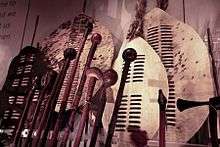Knobkierie

A Knobkierie, also spelled knobkerrie, knopkierie or knobkerry, is a form of club used mainly in Southern and Eastern Africa. Typically they have a large knob at one end and can be used for throwing at animals in hunting or for clubbing an enemy's head.[1] The knobkierie is carved from a branch thick enough for the knob, with the rest being whittled down to create the shaft.
The name derives from the Afrikaans word knop, meaning knot or ball and the Nama (one of the Khoekhoe languages) word kierie, meaning cane or walking stick. The name has been extended to similar weapons used by the natives of Australia, the Pacific islands and other places.
Knobkieries were an indispensable weapon of war, particularly among southern Nguni tribes such as the Zulu (as the iwisa) and the Xhosa. Knobkieries was occasionally used during World War I.[2][3] The weapon also being carried by British soldiers in Siegfried Sassoon's fictionalised autobiography.
During the Apartheid era in South Africa, they were often carried and used by protesters and sometimes by the police opposing them.[4][5]
Knobkieries are still widely carried, especially in rural areas, while in times of peace it serves as a walking-stick. The head, or knob, is often ornately carved with faces or shapes that have symbolic meaning. The knobkierie itself serves this function on the current South African Coat of Arms[6] and on the Order of Mendi for Bravery.[7] A knobkierie also appeared on the flag of Lesotho 1987-2006, the Coat of Arms of Lesotho since its independence in 1966 as well as the Coat of Arms of the Republic of Ciskei.
See also
- Rungu (weapon) - a similar club common in East Africa
- Shillelagh
- Wilbur Smith, the South African Author, in his book "When the lion feeds" also refers to these weapons as kerrie, which are used to throw at birds and animals in the bush to kill them.
References
- ↑ Rudolph, C. J. A guide for the Zulu court interpreter. Pietermaritzberg: Shuter & Shooter.
- ↑ Canada in the Great World War: an authentic account of the military history of Canada from the earliest days to the close of the war of the nations. Toronto: United Publishers of Canada. 1918.
- ↑ Dawson, Alec John (1918). A "Temporary gentleman" in France; home letters from an officer at the front. London, New York: Putnam. p. 94.
- ↑ "Amnesty Hearing - Vlisi Thokozani Manqele". Department of Justice and Constitutional Development. 1999-02-01. Retrieved 2008-11-27.
- ↑ "Amnesty Hearing - Victor Mthandeni Mthembu". Department of Justice and Constitutional Development. 1998-07-06. Retrieved 2008-11-27.
- ↑ "National Coat of Arms". South African Government Information. Retrieved 2008-11-27.
- ↑ "National Orders". The Presidency of the Republic of South Africa. Archived from the original on September 15, 2008. Retrieved 2008-11-27.
Suggested Reading
| Wikimedia Commons has media related to Knobkerries. |
- Dougherty, Terri. Zulu Warriors. New York: Capstone Press. (2008)
- Journal of Natal and Zulu history. University of Natal. Dept. of History. Durban: South Africa. (1992)
- Knight, Ian. The Zulus. London: Osprey Press. (1989)